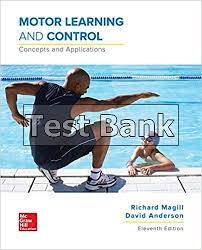Description
Test Bank For Motor Learning and Control Concepts and Applications 11th Edition by Richard A Magill
Chapter 02 The Measurement of Motor Performance Answer Key
Multiple Choice Questions
1.
Which of the following would be considered a performance outcome measure?
A. The distance a ball was kicked
B. The angle of the knee at ball impact
C. The electrical activity in the quadriceps muscles during the kick
D. The electrical activity in the brain during the kick
Accessibility: Keyboard Navigation
Topic: Discussion
2.
Which of the following would be considered a performance production measure?
A. The height of a jump
B. The time to complete a jump
C. The number of successful jumps to reach a target
D. The joint torque at the knee just prior to take off during a jump
Accessibility: Keyboard Navigation
Topic: Discussion
3.
Which two events mark the beginning and the end of the interval known as reaction time?
A. Warning signal and stimulus signal
B. Stimulus signal and initiation of the response
C. Stimulus signal and the completion of the response
D. Warning signal and the initiation of the response
Accessibility: Keyboard Navigation
Topic: Discussion; Reaction Time
4.
When RT is fractionated, the interval that represents the time it takes to receive and transmit information from the environment is referred to as the:
A. Premotor time
B. Motor time
C. Discrimination time
D. Response time
Accessibility: Keyboard Navigation
Topic: Discussion; Reaction Time
5.
An individual must respond to only one of several signals presented in this type of reaction time.
A. Simple RT
B. Choice RT
C. Discrimination RT
D. Serial RT
Accessibility: Keyboard Navigation
Topic: Discussion; Reaction Time
6.
This error measure evaluates performance consistency during a series of trials.
A. AE
B. CE
C. VE
D. E
Accessibility: Keyboard Navigation
Topic: Discussion; Error Measures
7.
This error measure evaluates overall accuracy during a series of trials.
A. AE
B. CE
C. VE
D. RE
Accessibility: Keyboard Navigation
Topic: Discussion; Error Measures
8.
To determine muscle activation patterns, this measurement method could be used.
A. EMG
B. EEG
C. Kinetics
D. Kinematics
Accessibility: Keyboard Navigation
Topic: Discussion; Kinematic Measures
9.
The change in spatial position of a limb is called:
A. Displacement.
B. Velocity.
C. Acceleration.
D. Linear motion.
Accessibility: Keyboard Navigation
Topic: Discussion; Kinematic Measures
10.
Displacement, velocity, and acceleration are ___________ measures of motion.
A. Kinetic
B. Kinematic
C. Force
D. Angular motion
Accessibility: Keyboard Navigation
Topic: Discussion; Kinematic Measures
11.
The term kinetics refers to motion caused by ___________.
A. Velocity
B. Angular acceleration
C. Force
D. Movement
Accessibility: Keyboard Navigation
Topic: Discussion; Kinematic Measures
12.
The measure of muscle activity that detects the lateral displacement of a muscle’s belly following maximal percutaneous neuromuscular stimulation is referred to as:
A. Electromyography (EMG)
B. Whole muscle mechanomyography (wMMG)
C. Electroencephalography (EEG)
D. Near infrared spectroscopy (NIRS)
Accessibility: Keyboard Navigation
Topic: Discussion; Kinetics
13.
Near infrared spectroscopy (NIRS) can be used to measure activity in the:
A. Brain
B. Muscles
C. Brain and muscles
D. None of these
Accessibility: Keyboard Navigation
Topic: Discussion; Kinetics
14.
EEG recordings will show __________ waves when the cerebral cortex is active.
A. Alpha
B. Beta
C. Theta
D. Delta
Accessibility: Keyboard Navigation
Topic: Discussions; Brain Activity Measures
15.
This brain activity measurement technique realigns hydrogen atoms in the body and may provide clear 2D and 3D images of the brain.
A. EEG
B. PET
C. EMG
D. fMRI





Be the first to review “Test Bank For Motor Learning and Control Concepts and Applications 11th Edition by Richard A Magill”